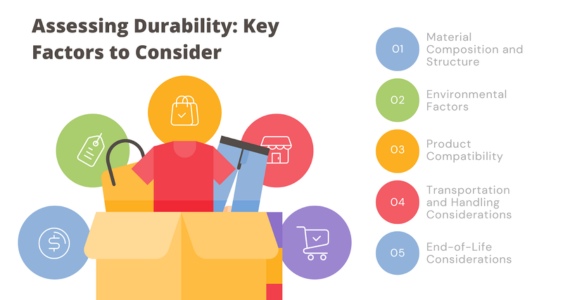Today, in our environmentally conscious world, there’s been a significant surge in demand for sustainable packaging solutions. As businesses strive to reduce their carbon footprint and minimize waste, the search for durable and eco-friendly packaging materials has become a top priority.
Nevertheless, achieving the delicate balance between sustainability and durability poses a considerable challenge. Read on, as this article delves into the factors determining the durability of sustainable packaging materials, offering critical insights for companies striving to make informed decisions.
The Rise of Sustainable Packaging
The traditional packaging industry has long relied on materials such as plastics, styrofoam, and non-biodegradable materials, which have contributed significantly to environmental pollution and resource depletion. As awareness of the negative impact of these materials has grown, consumers and regulatory bodies have exerted increasing pressure on businesses to adopt more sustainable practices.
Enter the realm of sustainable packaging materials, where innovative ingredients sourced from renewable sources—such as plant-based fibers, recycled materials, and biodegradable polymers—are gaining traction.
These materials offer a promising solution to the packaging industry’s environmental challenges, but their durability and strength must be carefully evaluated to ensure they can withstand the rigors of transportation, storage, and handling.
Assessing Durability: Key Factors to Consider
When assessing the durability of sustainable packaging materials, several factors come into play. Understanding these elements is crucial for manufacturers, retailers, and logistics providers to make informed decisions that balance environmental responsibility and product protection.

Material Composition and Structure
A packaging material’s composition and structure significantly influence its durability. Plant-based materials, such as bamboo, hemp, and mushroom-derived packaging, offer unique properties that can contribute to their strength and resilience. For instance, bamboo is known for its lightweight yet robust nature, making it an attractive option for packaging applications requiring durability without excessive weight.
Similarly, the structure of the material can impact its durability. Corrugated cardboard, for instance, owes its strength to its unique construction, with alternating ridges and grooves that provide enhanced rigidity and resistance to compression.
It’s crucial to understand the intrinsic properties of sustainable materials and their structural characteristics when assessing their suitability for specific packaging requirements.
Environmental Factors
Packaging materials often face a range of environmental challenges during their lifecycle, from exposure to moisture and humidity to temperature fluctuations and UV radiation. Sustainable materials must be evaluated for their ability to withstand these environmental stressors without compromising their structural integrity or performance.
For example, biodegradable plastics derived from plant-based sources may be susceptible to moisture absorption, potentially affecting their strength and durability over time. On the other hand, materials like recycled paper or cardboard may be more resistant to moisture but could be vulnerable to UV degradation or temperature extremes.
Conducting rigorous testing under simulated environmental conditions is essential for gauging the durability of sustainable packaging materials and ensuring they can maintain their protective qualities throughout the supply chain.
Product Compatibility
The durability requirements of the packaging material can also be influenced by the nature of the products being packaged. For instance, packaging for fragile or heavy items may require materials with superior impact resistance and compressive strength. In contrast, packaging for lightweight or non-fragile products may prioritize factors such as moisture resistance or breathability.
It’s crucial to evaluate the compatibility between the sustainable packaging material and the specific product characteristics to ensure adequate protection and prevent damage during transit or storage.
This assessment may involve testing the material’s performance under various loading conditions, vibration simulations, or drop tests to verify its ability to effectively safeguard the product.
Transportation and Handling Considerations
The packaging industry operates within a complex logistical landscape, with materials subjected to various handling processes, transportation modes, and storage conditions. Sustainable packaging materials must be evaluated for their durability in the face of these challenges, including the potential for abrasion, compression, and impact during loading, unloading, and transportation.
Materials such as molded fiber packaging or biodegradable foams may offer exceptional cushioning properties, effectively protecting products from shocks and vibrations. However, their resilience to repeated handling and stacking must be assessed to ensure they maintain their protective qualities throughout the supply chain.
Collaborating with logistics partners and conducting real-world testing scenarios can provide valuable insights into the durability of sustainable packaging materials in realistic transportation and handling conditions.
End-of-Life Considerations
While durability is crucial during the packaging lifecycle, it’s equally important to consider the material’s end-of-life implications. Sustainable packaging materials should ideally be designed for recyclability, compostability, or biodegradability, aligning with the principles of a circular economy.
Materials that are durable during use but fail to decompose or be recycled effectively may ultimately contribute to waste accumulation and environmental pollution. Striking the right balance between durability and end-of-life sustainability is crucial for achieving a truly sustainable packaging solution.
Manufacturers and packaging designers should consider the entire lifecycle of their materials, incorporating design principles that facilitate easy disassembly, component separation, and compatibility with existing recycling or composting infrastructure.
Advancing Sustainable Packaging Through Collaboration
Assessing the durability of sustainable packaging materials is a complex endeavor that requires a multifaceted approach. Collaboration between material manufacturers, packaging designers, product manufacturers, logistics providers, and recycling authorities is essential to ensure a holistic understanding of the durability requirements and end-of-life considerations.
By fostering open communication and knowledge-sharing, stakeholders can collectively identify the most suitable sustainable materials for specific applications, optimize their performance through innovative design and testing methodologies, and develop best practices for handling and transportation.
Moreover, continuous research and development efforts are crucial to advancing the field of sustainable packaging materials. Exploring new material compositions, structures, and manufacturing processes can unlock novel solutions that combine superior durability with environmental sustainability.
Conclusion
As the world embraces sustainability, the packaging industry stands at a pivotal juncture, tasked with finding durable and eco-friendly solutions that protect products while minimizing environmental impact. Assessing the durability of sustainable packaging materials is a multifaceted endeavor that requires a comprehensive understanding of material properties, environmental factors, product compatibility, and logistical considerations.
By collaborating with stakeholders across the supply chain, conducting rigorous testing, and prioritizing end-of-life sustainability, businesses can make informed decisions that strike the right balance between durability and environmental responsibility. Ultimately, achieving truly sustainable packaging solutions depends on continuous innovation, adaptation, and a shared commitment to protecting both products and the planet.
Frequently Asked Questions (FAQs)

What exactly does the term “durability factor” refer to in the context of sustainable packaging materials?
The durability factor evaluates the strength, resilience, and long-term performance of packaging materials in various environmental conditions. It considers factors such as resistance to physical stress, moisture, temperature changes, and degradation over time, providing insights into the material’s ability to maintain product integrity and reduce environmental impact throughout its lifecycle.
How can the durability factor influence the choice of sustainable packaging materials for businesses?
By assessing the durability factor, businesses can make informed decisions about selecting packaging materials that strike a balance between environmental sustainability and functional performance. Materials with a high durability factor are more likely to withstand the rigors of transportation, storage, and handling, reducing the risk of product damage, spoilage, and waste. This can ultimately lead to cost savings, improved brand reputation, and enhanced sustainability credentials for the business.
What are some common methods used to measure the durability factor of sustainable packaging materials?
Various testing protocols and standards exist to evaluate the durability factor of packaging materials, including compression tests, impact resistance tests, tensile strength tests, and accelerated aging tests. These methods help quantify the material’s physical properties, structural integrity, and resistance to environmental factors, providing valuable data for comparing different packaging options and ensuring they meet the required standards for durability and sustainability.
See Also: Exploring Bottle Filling Technologies: A Guide To China Packaging Machine Manufacturers










